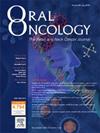肿瘤浸润深度对舌癌对侧颈部病变的预测价值
IF 4
2区 医学
Q1 DENTISTRY, ORAL SURGERY & MEDICINE
引用次数: 0
摘要
目的对于侧位良好的口腔舌鳞状细胞癌(OTSCC)对侧cN0颈部的处理存在争议。浸润深度(DOI)是同侧结节转移的有力预测指标。本研究探讨了 DOI 能否预测对侧颈部疾病 (CND)。材料与方法对 2014 年至 2021 年在一家三级医疗学术机构接受初次手术治疗的侧位 OTSCC 患者进行了回顾性分析。结果155例患者纳入研究。101例(65.2%)患者患有T1/T2疾病,54例(34.8%)患者患有T3/T4疾病。22例(14.2%)患者患有CND。有 CND 和无 CND 患者的平均 DOI 分别为 21.0 毫米和 9.8 毫米(p < 0.001)。单变量回归模型显示,较高的 DOI 与总体 CND 风险增加有关(OR = 1.11,95% CI:1.06,1.17,p < 0.001),在 T1 疾病患者中(OR = 1.38,95% CI:1.11,2.20,p = 0.038),在 cN0 疾病患者中(OR = 1.09,95% CI:1.01,1.17,p = 0.028)。多变量回归模型证实,DOI越高,CND风险越高(OR = 1.09,95% CI:1.04, 1.16,p = 0.001)。结论DOI被认为是OTSCC中CND的一个预测因素。在进行同侧颈部切除术时,DOI ≥ 6 mm 可能是与 CND 风险增加相关的阈值,这表明可以考虑进行对侧颈部处理。本文章由计算机程序翻译,如有差异,请以英文原文为准。
The predictive value of tumor depth of invasion for contralateral neck disease in tongue cancer
Objective
Management of the contralateral cN0 neck in well-lateralized oral tongue squamous cell carcinoma (OTSCC) is controversial. Depth of invasion (DOI) is a strong predictor of ipsilateral nodal metastases. This study examines if DOI can predict contralateral neck disease (CND).
Material and Methods
A retrospective analysis was performed on patients treated with primary surgery for lateralized OTSCC at a single tertiary care academic institution from 2014 to 2021. Multivariable analysis was performed to assess the relationship between DOI and CND.
Results
155 patients were included. 101 (65.2%) patients had T1/T2 disease, while 54 (34.8%) had T3/T4 disease. 22 (14.2%) patients had CND. Mean DOI of patients with CND and without CND was 21.0 mm and 9.8 mm (p < 0.001), respectively. Univariable regression models showed higher DOI was associated with increased risk of CND overall (OR = 1.11, 95% CI: 1.06, 1.17, p < 0.001), in patients with T1 disease (OR = 1.38, 95% CI: 1.11, 2.20, p = 0.038), and in patients with cN0 disease (OR = 1.09, 95% CI: 1.01, 1.17, p = 0.028). Multivariable regression model confirmed higher DOI was associated with increased risk of CND (OR = 1.09, 95% CI: 1.04, 1.16, p = 0.001). A DOI of 6 mm was identified as a potential threshold for increased risk of CND.
Conclusion
DOI was identified as a predictive factor for CND in OTSCC. At the time of ipsilateral neck dissection, a DOI ≥ 6 mm may represent a threshold associated with an increased risk of CND, indicating that contralateral neck management could be considered.
求助全文
通过发布文献求助,成功后即可免费获取论文全文。
去求助
来源期刊

Oral oncology
医学-牙科与口腔外科
CiteScore
8.70
自引率
10.40%
发文量
505
审稿时长
20 days
期刊介绍:
Oral Oncology is an international interdisciplinary journal which publishes high quality original research, clinical trials and review articles, editorials, and commentaries relating to the etiopathogenesis, epidemiology, prevention, clinical features, diagnosis, treatment and management of patients with neoplasms in the head and neck.
Oral Oncology is of interest to head and neck surgeons, radiation and medical oncologists, maxillo-facial surgeons, oto-rhino-laryngologists, plastic surgeons, pathologists, scientists, oral medical specialists, special care dentists, dental care professionals, general dental practitioners, public health physicians, palliative care physicians, nurses, radiologists, radiographers, dieticians, occupational therapists, speech and language therapists, nutritionists, clinical and health psychologists and counselors, professionals in end of life care, as well as others interested in these fields.
 求助内容:
求助内容: 应助结果提醒方式:
应助结果提醒方式:


